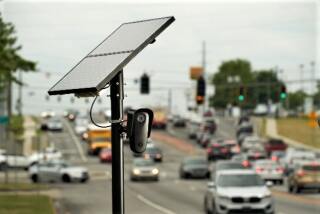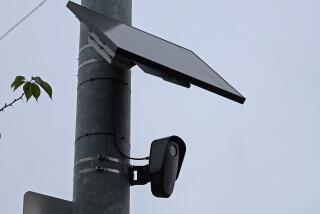Red Lights, Cameras, Infractions for Scofflaws
- Share via
Next time the light turns green at an intersection, try pausing a few seconds before you step on the gas. It may actually save your life.
You never know when some reckless road warrior or distracted driver rushing to work will barrel through a red light and smash any vehicle in their paths.
Red-light running has become one of the most dangerous acts of aggressive driving in the United States, according to federal transportation and emergency trauma officials.
Last year in Los Angeles alone, 37 people were killed and 8,000 were injured in accidents involving red-light running, says Stephanie Saari, a spokeswoman for the Western Insurance Information Service, an education and research group.
California leads the nation in accidents resulting from red-light running, Saari says. The number of citations issued for all light-running offenses rose 8%, from 23,280 to 25,345, from 1996 to 1997.
This sharp increase reflects a disturbing trend in driving behavior, say law enforcement officials and safety advocates. It has become the biggest cause of urban collisions and injuries.
Red-light running causes about 260,000 crashes yearly across the nation, the Insurance Institute for Highway Safety estimates. These crashes are often serious or deadly because they typically involve one vehicle striking another in the side, where there are only a few inches of buffer protecting the passenger.
*
It’s infuriating that so many careless and reckless drivers believe they can push the envelope and blow through a red light with impunity. How can any driver justify risking the lives of others in order to gain a few minutes or the cheap satisfaction of beating a light?
Last spring, the U.S. Department of Transportation, the American Trauma Society and Chrysler Corp. joined in launching a campaign to publicize the dangers of running red lights and to encourage police to step up enforcement of traffic laws.
While such educational efforts can only help, the use of red-light cameras has had the most dramatic effect on curbing the problem in cities where they are used, Saari says.
In fact, when cameras were installed at key intersections in San Francisco and Oxnard, there was a 42% drop in citations for red-light violations. Interestingly, light running decreased even at intersections where there were no cameras, Saari says.
The cameras, installed at problem intersections and tripped by sensors buried in the pavement, snap photographs of vehicles that race into the intersection after the signal has turned red.
Within two weeks, the picture and ticket are mailed to the registered owner of the vehicle. The fine is $271 and adds a point against the owner’s driving record.
New technology is also being developed to sense when a vehicle is about to run a red light and prevent accidents by holding back other traffic with a longer red light, Saari says.
If safety advocates and transportation officials are successful in their campaigns to warn the public of the danger of red-light running and convince us of the necessity for cameras to catch the culprits, there may be hope for reversing this dangerous driving trend.
The cameras are already snaring violators in Beverly Hills, San Diego and other cities around the U.S. Los Angeles has tested the technology and is expected to be added to the list.
*
But use of the cameras has drawn fire from critics who argue that such systems violate people’s privacy and are being installed primarily to generate more revenue for cities. Others complain that the cameras catch drivers making right-hand turns or other maneuvers that would not typically result in citations by a police officer.
There is even a new product on the market for those fearful of being caught on red-light cameras. Flash Photo Deflector Fluid, from Northwest Products Marketing of Bellevue, Wash., is a spray designed to make license plate numbers and letters illegible to the sensors.
California Assemblyman Tom McClintock (R-Northridge) is so incensed about what he calls “reverse ATMs at intersections” that he plans to introduce legislation to repeal the bill that authorized the cameras in the first place.
McClintock argues that the technology is being employed “not for public safety but to raise money both for governments and the [camera] companies who are assured a cut of every ticket produced.”
He cites a camera at the corner of Wilshire and La Cienega boulevards in Beverly Hills that reportedly issues about 100 tickets a day. “That’s $27,000 of gross revenue daily,” he says, and that’s just one location.
“Yes, the cameras will catch the scofflaws,” McClintock says, but he contends that some people are being ticketed when they are only inches over the limit line when the light has changed.
“A traffic officer can tell the difference between a reckless act and a harmless misjudgment. The camera can’t,” he says.
*
But Saari of the Western Insurance Information Service contends that saving lives is what’s at stake here. She stresses that red-light running remains a serious hazard and that the cameras are not installed just to make more money.
Saari also dismisses the “Big Brother” argument. Sure, citizens have a right to personal privacy. “But driving is a public activity,” she says. “It’s regulated, and you have to have a license to drive.”
“No one has the right to kill or endanger others by violating the law and running a red light,” adds Candysse Miller, the insurance information service’s regional director.
Why do drivers take such risks?
“Maybe it’s the time-pressured society we live in,” Miller says. “Maybe they get a feeling of victory if they beat a light.”
To protect yourself, Saari recommends pausing when the light turns green and looking both ways before you go. “That’s what I do, and it’s saved me.”
*
Jeanne Wright cannot answer mail personally but will attempt to respond in this column to automotive questions of general interest. Write to Your Wheels, Business Section, Los Angeles Times, Los Angeles, CA 90053. Via e-mail: [email protected].
More to Read
Sign up for Essential California
The most important California stories and recommendations in your inbox every morning.
You may occasionally receive promotional content from the Los Angeles Times.










